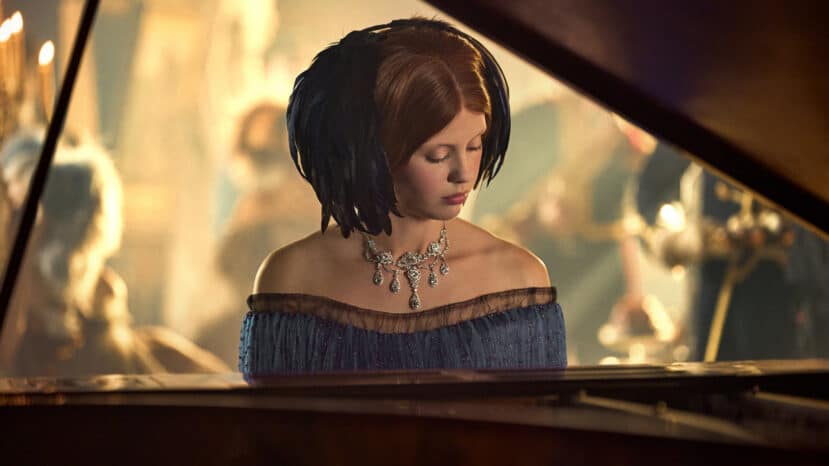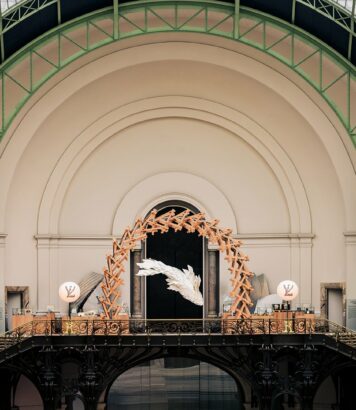Tiffany’s Wade necklace, the other star of the Frankenstein of 2025

In 2025, Tiffany& Co. resurrects a forgotten treasure: the Wade necklace, a 1900 jewel weighing over 40 carats, worn by Mia Goth in Guillermo del Toro’s new Frankenstein. The piece, unseen for over a century, embodies the fusion of historical craftsmanship and cinematic storytelling, according to sources from the studio and the New York-based house.
A century-old jewel in the spotlight
Created in 1900 by Paulding Farnham, the Wade necklace by Tiffany & Co. blends platinum and 18-carat gold in a light-hearted “Garland” style. Long preserved in the Tiffany Archives, it had never been worn in modern times before its reappearance in the film. According to luxury experts, this piece symbolizes a return to the emotion of heritage, where the material tells as much as the design.
Director Guillermo del Toro, a passionate craftsman, personally chose this necklace for his heroine, Elizabeth, played by Mia Goth. Its diamond brilliance, estimated at over
L’atelier Tiffany, partner of the cinema
Since October 2025, Tiffany & Co. has been collaborating artistically with the film production, supplying twenty-seven pieces from its current archives and workshops. The costume designers have integrated these creations into the narrative texture, rendering each piece of jewelry a bearer of a symbolic role. Our survey confirms that Charles Dance, for example, wears a Tiffany pocket watch, while other characters wear bracelets designed for the film.
Christopher Young, Vice President Creation at Tiffany & Co. describes the partnership as a “rare artistic collegiality between jeweler and director”. This partnership follows in the footsteps of the company’s previous collaborations with the seventh art, recalling the diamond in “Breakfast at Tiffany’s”. The aim: to make jewelry a narrative vehicle, not just an aesthetic one.
When goldsmithing becomes a scenario
Every camera movement on this Wade necklace is not insignificant: it reflects Elizabeth’s destiny as a captive of beauty and power. Sources close to costume designer Kate Hawley confirm that “its brilliance had to express the ambivalence between life and death”. The result is a striking balance between historical object and modern storytelling.
On screen, the hand-cut diamonds sparkle to the rhythm of the story. Restoring them to their European cuts, typical of the turn of the last century, required meticulous restoration work under the supervision of Tiffany craftsmen. Their natural brilliance, without digital retouching, lends a rare authenticity to an international film production.
“Tiffany’s jewelry became its own creative contribution to our film’s language” – Kate Hawley, principal costume designer
A symbolic rebirth of heritage
The revival of jewellery heritage in contemporary cinema is attracting iconic houses. In a market saturated with digital images, rediscovered period jewelry brings a tangible emotion, an anchoring in the material. According to industry professionals, this approach reflects a desire to reconnect luxury with its essence: human know-how.
The film’s scheduled theatrical release on October 17, prior to its release on Netflix on November 7, 2025, promises to anchor Tiffany in the global imagination. This choice of simultaneous launch combines historical prestige and digital modernity, a strategy calculated to boost the company’s global visibility. The heritage aspect of the jewels, highlighted in the campaigns, makes them the focal point of the communication.
“Frankenstein extends Tiffany’s tradition of storytelling far beyond the display windows” – Christopher Young, VP Creation Tiffany & Co.
Between authenticity and modernity
Unlike other commercial partnerships, Tiffany’s partnership with the film *Frankenstein* is based on a faithful reconstruction of the period, without ostentatious branding. The craftsmen restored original pieces using setting techniques dating back to 1900. Respect for the ancient processes adds to the credibility of the work.
The preliminary critical reception hailed this respectful approach to heritage. The first screenings in Venice unveiled a jewel as emblematic as the heroine. Some observers of the cinema experience already see it as a potential Oscar nomination for art direction.
For lovers of jewelry and visual culture, this collaboration illustrates a major transformation: jewelry becomes a language of expression, and each stone a word in the script. It also confirms the cultural vitality of century-old houses capable of redefining their heritage through contemporary artistic innovation.





No comments
Post a comment
Always participate in accordance with the law and with respect for others.